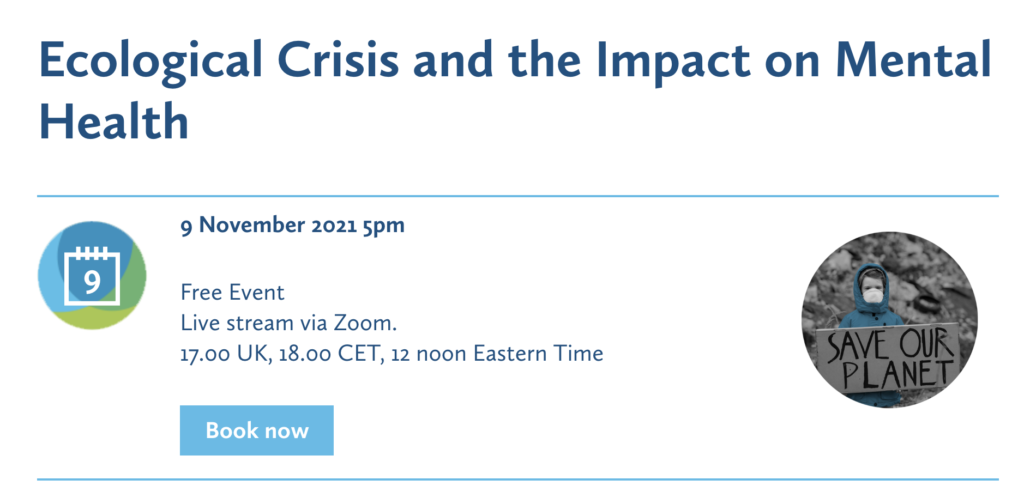
Climate change poses an extensive risk to humanity and may have significant negative effects on mental health (Wu et al., 2020). Eco-anxiety describes an increasingly recognised anxiety related to the threat of environmental disaster driven by climate change (Cunsolo, et al., 2020). Similarly, ecological grief represents grief in response to the climate crisis (Cunsolo, et al., 2020). Such anxiety and grief may compound other stressors and mental health issues, and young people may be especially at risk (Wu et al., 2020). However, the majority of publications related to this topic are found in the news media rather than scientific literature (Ojala, et al 2021), limiting our knowledge or understanding of the issue.
The media provides insight into peoples’ experiences of current issues such as climate change (Gifford & Gifford, 2016). Media portrayals also play an important role in shaping the master narratives that guide people’s behaviour and responses to different events (Mclean & Syed, 2016), and especially novel situations. By presenting and framing peoples’ responses to issues, whether positively or negatively, the media offers insight into people’s experiences, and perspectives on what actions are considered appropriate to different events (Gifford & Gifford, 2016; Taveres, et al., 2020). Given the evolving nature of the climate crisis and associated mental health challenges, the media may provide a first port of call for understanding people’s experiences of the situation, while also contributing to individuals’ responses to climate change (Taveres, et al., 2020).
In the current study, Benoit, Thomas and Martin (2021) undertook a scoping review of discourses found in major American newspapers about children and their parents in the context of climate change. Through this review, the authors sought to better understand experiences of ecological grief and eco-anxiety by identifying common depictions of youth responses to climate change and adults’ reactions to young people’s responses.

Young people are increasingly concerned about climate change; however, little research has addressed how to support young people to manage ecological anxiety.
Methods
The researchers conducted a scoping review of published newspaper articles addressing youth responses to climate change along with related adult attitudes to their responses. Published articles between January 2018 and April 2021 were sourced from six of the top 10 circulated American newspapers that reflected the US political spectrum. The researchers included three leading national newspapers: USA Today, Wall Street Journal, and The New York Times; and three top newspapers from diverse metropolitan areas: The Washington Post, Los Angeles Times, and The Chicago Tribune.
Inclusion criteria for the study were not specifically stated, however, the search terms used to find relevant articles via Google and the respective newspapers’ websites included: “climate change”, “climate crisis”, “global warming”, “ecology”, or “eco-anxiety”, and “kids”, “child”, “teens”, “teenager”, “adolescent”, “young”, “youth”, “parent”, or “family”. Furthermore, the 131 articles selected for analysis described child or adolescent reactions to the climate crisis, as well as adults’ attitudes to these responses. There were no specific exclusion criteria stated.
Qualitative discourse analysis was conducted on the salient statements and quotes in the articles. Two of the authors coded all of the articles independently; although codes and overarching patterns were developed collaboratively during the analysis.
Results
The authors grouped their main discourse analysis findings into two categories, each with specific subcategories:
- Children and adolescents: Comprised of their ecological awareness, anxiety and actions;
- Parents and adults: Representing reactions in response to youths’ concerns.
1. Children and adolescents
The authors identified four main representations in the discourse on young people and climate change in the reviewed articles:
- The first was titled Fierce young activists: Emboldened and demanding, and was a common positive representation of young people who were taking collective action against climate change.
- The second was Adultified children, which depicted young people as taking on the responsibilities of adults because they felt neglected and let down by adults’ responses to climate change, and especially those of politicians.
- The third depiction was that of Innocent victims at the mercy of climate change, where young people were described as helpless victims of climate change who need sympathy because they will have to face the consequences and associated mental health issues of the climate crisis.
- The fourth discourse was titled Ultimate saviours of humanity: unsolicited burden on small shoulders and characterised children as environmental problem solvers who would be ultimate saviours of humanity by educating others and finding solutions to the problem.
2. Parents and adults
Four main representations of parents and adults were also identified by the authors:
- The first was named Experiencing eco-anxiety through parenthood, capturing a dominant narrative of how becoming a parent makes the climate crisis more urgent due to concerns for their children’s future.
- The next discourse was titled Taming children’s eco-anxiety. Parents are expected to spare offspring their own anxieties, and this represented the way that advice to parents often encouraged them to minimise the emotional distress they shared with their children in relation to climate change by focusing on action and ensuring a peaceful family routine while preparing for disaster.
- The third discourse, Criticising youth-led activism, focused on why children should not be activists because they do not have the maturity to understand or lead change on large political issues, are breaking social norms for childhood or societal traditions, or are indoctrinated by adults and should not bear the burden of responsibility.
- The final discourse, Transcendence: reimagining ourselves, our world, and climate action, was less common but focused on the way that existential concerns driven by climate change are an opportunity for personal growth, societal change, and spirituality.

US newspapers depict young people in relation to climate change as demanding activists, adultified children, innocent victims, or ultimate saviours, whereas parents are encouraged to manage their children’s anxiety while preparing for disaster.
Conclusions
The authors concluded:
Newsprint media has shed light on the potential for youth climate action to bring about individual and systemic change but also tended to oversimplify the views of young people and their parents. Child and adolescent mental health care providers should be aware of the lay media’s narratives regarding children’s reactions to ecological challenges, and to support parents avoid the trap of childism.

Health providers should be aware of the different media narratives, as they may play an important role in shaping young people’s eco-anxiety or ecological grief and their parents’ associated responses.
Strengths and limitations
This study provides novel perspectives on the lay narratives that represent children and parents in the context of climate change, which is timely and relevant given the recent COP26 UN Climate Change Conference. By clearly delineating the dominant master narratives, the authors provide insight into the way that young people and their parents are encouraged to belong and be good members of their culture when dealing with climate change and the related anxieties and grief (Mclean & Syed, 2016). Importantly, these narratives provide a novel framework that practitioners can use when supporting both young people and their parents to understand and manage eco-anxiety. Despite these strengths, there are several limitations to the work.
Although the research was described as a scoping review, the methods in this paper do not follow current best practice guidelines for conducting scoping reviews (Peters et al., 2020). Some of the missing elements in the article include a clearly stated aim and associated research questions, specific inclusion and exclusion criteria, and a clear summary of the data extraction and charting process (Peters et al., 2020). Although some of the guidelines may not be relevant to a narrative synthesis of newspaper articles, further reporting of the methodology would help increase clarity and reproducibility of the work.
The focus on US-only newspaper depictions might limit the relevance of the review for international readers. This may be especially the case for those from European and other non-western nations, as a recent review on youth perceptions of climate change found that levels of belief, concern, and willingness to act were lower in the United States, UK, and Australia than in other countries (Lee et al., 2021). Nevertheless, it is possible that despite differences in youth perceptions, media depictions are similar across different nations, and further research is warranted to identify if this is the case.
More broadly, by only including newspaper articles as a data source, the research misses other important media sources, as acknowledged by the authors. However, this may be particularly problematic given the focus on depictions of youth. Young people are much less likely to access newspapers than other forms of media such as TV or social media (Twenge, et al., 2019). This means that although the current depictions likely influence adult perspectives, they may be less influential for young people. Understanding whether similar depictions appear in other media forms, and how much young people understand or endorse the different narratives would help strengthen the conclusions that can be drawn about the impact these narratives have on young people.

Whilst providing novel insights, this paper does not follow guidelines for conducting a scoping review and is therefore not reproducible.
Implications for practice
Practitioners working with young people can consider these narratives when addressing young people’s and their parents’ reactions to climate change. This may empower parents to better understand and process their own anxieties and those of their children, and support young people to do the same.
More research is needed on this topic, but if similar narratives are identified in other media formats and countries, media guidelines could be developed that encourage positive and empowering media portrayals of young people and their parents facing climate change. This may support a reduction in anxiety and grief related to the climate crisis and inspire people to take meaningful action that benefits both themselves and the planet.

Future research using a wider variety of media formats and exploring young people’s perspectives on the different narratives would help strengthen possible conclusions.
Statement of interests
No conflicts of interest.
#CAMHScampfire
Join us around the campfire to discuss this paper
The elves are organising an online journal club to discuss these papers with the lead author Dr Laelia Benoit, a group of young climate activists, expert clinicians, and our good friends at ACAMH (the Association of Child and Adolescent Mental Health). We will discuss the research and its implications. The webinar will be facilitated by André Tomlin (@Mental_Elf).
The focus will be on critical appraisal of the research and implications for practice. Primarily targeted at CAMHS practitioners, and researchers, ‘CAMHS around the Campfire’ will be publicly accessible, free to attend, and relevant to a wider audience.
It’s taking place at 5-6pm GMT on Tuesday 9th November and you can sign up for free on the ACAMH website or follow the conversation at #CAMHScampfire. See you there!
Links
Primary paper
Benoit, L., Thomas, I., & Martin, A. (2021). Ecological awareness, anxiety, and actions among youth and their parents–a qualitative study of newspaper narratives. Child and Adolescent Mental Health.
Other references
Cunsolo, A., Harper, S. L., Minor, K., Hayes, K., Williams, K. G., & Howard, C. (2020). Ecological grief and anxiety: the start of a healthy response to climate change? The Lancet Planetary Health, 4(7), e261-e263.
Gifford, E., & Gifford, R. (2016). The largely unacknowledged impact of climate change on mental health. Bulletin of the Atomic Scientists, 72(5), 292-297.
Lee, K., Gjersoe, N., O’Neill, S., & Barnett, J. (2020). Youth perceptions of climate change: A narrative synthesis. Wiley Interdisciplinary Reviews: Climate Change, 11(3), e641.
Ojala, M., Cunsolo, A., Ogunbode, C. A., & Middleton, J. (2021). Anxiety, Worry, and Grief in a Time of Environmental and Climate Crisis: A Narrative Review. Annual Review of Environment and Resources, 46.
Peters, M. D., Marnie, C., Tricco, A. C., Pollock, D., Munn, Z., Alexander, L., … & Khalil, H. (2020). Updated methodological guidance for the conduct of scoping reviews. JBI evidence synthesis, 18(10), 2119-2126.
Tavares, A. O., Areia, N. P., Mellett, S., James, J., Intrigliolo, D. S., Couldrick, L. B., & Berthoumieu, J. F. (2020). The European media portrayal of climate change: Implications for the social mobilization towards climate action. Sustainability, 12(20), 8300.
Twenge, J. M., Martin, G. N., & Spitzberg, B. H. (2019). Trends in US Adolescents’ media use, 1976–2016: The rise of digital media, the decline of TV, and the (near) demise of print. Psychology of Popular Media Culture, 8(4), 329.
Wu, J., Snell, G., & Samji, H. (2020). Climate anxiety in young people: a call to action. The Lancet Planetary Health, 4(10), e435-e436.
Photo credits
- Photo by Carlos Roso on Unsplash
- Photo by Callum Shaw on Unsplash
- Photo by Roman Kraft on Unsplash
- Photo by Kelly Sikkema on Unsplash
- Photo by Karsten Würth (➡️ @karsten.wuerth) on Unsplash
- Photo by Nikola Jovanovic on Unsplash

